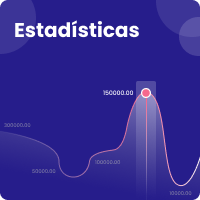Implementación de mapas cognitivos difusos con algoritmos genéticos para predecir diabetes mellitus tipo 2
Resumen
La diabetes mellitus tipo 2 es una enfermedad crónica no transmisible, causada por un trastorno en el metabolismo de la glucosa, que provoca un aumento anormal de su concentración en la sangre. El diagnóstico tardío de esta enfermedad contribuye al aumento de las tasas de morbilidad y mortalidad a nivel mundial. El desarrollo de modelos basados en inteligencia artificial para la predicción de diabetes podría acelerar el diagnóstico. Por tanto, el objetivo del presente estudio fue implementar un modelo de predicción de diabetes mellitus tipo 2 basado en mapas cognitivos difusos entrenado con un algoritmo genético. La metodología empleada consistió en utilizar un conjunto de datos del Instituto Nacional de Diabetes y Enfermedades Digestivas y Renales de la población de indios PIMA, que contiene información demográfica y clínica de 768 pacientes. El 70 % de los datos se empleó para el entrenamiento y validación, y el 30 % restante se utilizó para las pruebas de rendimiento. El modelo de mapas cognitivos difusos puede predecir la enfermedad con un 99 % de exactitud, 98 % de precisión y recall de 100 %. Se concluye que el modelo presenta una buena capacidad para predecir y evaluar el comportamiento de las variables de interés en la diabetes mellitus tipo 2, mostrando su valor como herramienta de soporte en la identificación oportuna de la enfermedad y apoyo a la toma de decisiones por parte del profesional médico.
Referencias bibliográficas
American Diabetes Association Professional Practice Committee et al., “2. Diagnosis and classification of diabetes: standards of care in diabetes—2024,” Diabetes Care, vol. 47, no. Supplement_1, pp. S20–S42, 2024. https://doi.org/10.2337/dc24-S002
World Health Organization. “Diabetes.” who.int. Accessed: Feb. 1, 2024. [Online.] Available: https://www.who.int/news-room/fact-sheets/detail/diabetes
D. J. Magliano, E. J. Boyko, and IDF Diabetes Atlas 10th edition scientific committee, IDF DIABETES ATLAS, Brussels: International Diabetes Federation, 2021. http://www.ncbi.nlm.nih.gov/books/NBK581934/
C. Bommer et al., “The global economic burden of diabetes in adults aged 20–79 years: a cost-of-illness study,” Lancet Diabetes Endocrinol., vol. 5, no. 6, pp. 423-430, Jun. 2017. https://doi.org/10.1016/S2213-8587(17)30097-9
J. Zhang et al., “The impact of global, regional, and national population ageing on disability-adjusted life years and deaths associated with diabetes during 1990–2019: A global decomposition analysis,” Diabetes Metab. Syndr. Clin. Res. Rev., vol. 17, no 6, p. 102791, Jun. 2023. https://doi.org/10.1016/j.dsx.2023.102791
I. Tasin, T. U. Nabil, S. Islam, and R. Khan, “Diabetes prediction using machine learning and explainable AI techniques,” Healthc. Technol. Lett., vol. 10, no. 1–2, pp. 1–10, Dec. 2023. https://doi.org/10.1049/htl2.12039
J. Abdollahi, and B. Nouri-Moghaddam, “Hybrid stacked ensemble combined with genetic algorithms for diabetes prediction,” Iran J. Comput. Sci., vol. 5, no 3, pp. 205-220, Sep. 2022. https://doi.org/10.1007/s42044-022-00100-1
A. Hennebelle, H. Materwala, and L. Ismail, “HealthEdge: A Machine Learning-Based Smart Healthcare Framework for Prediction of Type 2 Diabetes in an Integrated IoT, Edge, and Cloud Computing System,” Procedia Comput. Sci., vol. 220, pp. 331-338, 2023. https://doi.org/10.1016/j.procs.2023.03.043
T. Mora, D. Roche, and B. Rodríguez-Sánchez, “Predicting the onset of diabetes-related complications after a diabetes diagnosis with machine learning algorithms,” Diabetes Res. Clin. Pract., vol. 204, p. 110910, Oct. 2023. https://doi.org/10.1016/j.diabres.2023.110910
A. Amirkhani, E. I. Papageorgiou, A. Mohseni, and M. R. Mosavi, “A review of fuzzy cognitive maps in medicine: Taxonomy, methods, and applications,” Comput. Methods Programs Biomed., vol. 142, pp. 129-145, Apr. 2017. https://doi.org/10.1016/j.cmpb.2017.02.021
A. M. Shukla, P. Pandit, V. Purandare, and A. Srinivasaraghavan, “Symptom based Hierarchical Classification of Diabetes and Thyroid disorders using Fuzzy Cognitive Maps,” Cornell University, no. 2, 2021. https://doi.org/10.48550/arXiv.2108.03760
A. Alam, “Fuzzy Cognitive Maps Approach to Identify Risk Factors of Diabetes,” Journal of Physical Sciences, vol. 22, pp. 13-21, 2017. https://vixra.org/pdf/1803.0471v1.pdf
W. Hoyos, K. Hoyos, and R. Ruiz-Pérez, “Modelo de inteligencia artificial para la detección temprana de diabetes,” Biomédica, vol. 43, no. Sp.3, pp. 110-121, Dec. 2023. https://doi.org/10.7705/biomedica.7147
S. Almufti, A. Yahya, and H. Khalid, “A comparative study of particle swarm optimization and genetic algorithm,” International Journal of Electrical Engineering, vol. 9, no. 2, pp. 215–223, 2016. http://www.irphouse.com/ijee16/ijeev9n2_06.pdf
J. W. Smith, J. E. Everhart, W. C. Dickson, W. C. Knowler, and R. S. Johannes, “Using the ADAP learning algorithm to forecast the onset of diabetes mellitus,” Proceedings of the Annual Symposium on Computer Application in Medical Care, p. 261, Nov.1988. https://www.ncbi.nlm.nih.gov/pmc/articles/PMC2245318/
UCI Machine Learning, and Kaggle Team “Pima Indians Diabetes Database.” Kaggle.com. Accessed: Feb. 1, 2024. [Online.] Available: https://www.kaggle.com/datasets/uciml/pima-indians-diabetes-database
N. V. Chawla, K. W. Bowyer, L. O. Hall, and W. P. Kegelmeyer, “SMOTE: Synthetic Minority Over-sampling Technique,” J. Artif. Intell. Res., vol. 16, pp. 321-357, Jun. 2002. https://doi.org/10.1613/jair.953
B. Kosko, “Fuzzy cognitive maps,” Int. J. Man-Mach. Stud., vol. 24. no. 1, pp. 65-75, Jan. 1986. https://doi.org/10.1016/S0020-7373(86)80040-2
I. D. Apostolopoulos, N. I. Papandrianos, N. D. Papathanasiou, and E. I. Papageorgiou, “Fuzzy Cognitive Map Applications in Medicine over the Last Two Decades: A Review Study,” Bioengineering, vol. 11, no. 2, p. 139, Jan. 2024. https://doi.org/10.3390/bioengineering11020139
W. Hoyos, J. Aguilar, and M. Toro, “A clinical decision-support system for dengue based on fuzzy cognitive maps,” Health Care Manag. Sci., vol. 25, no. 4, pp. 666-681, Dec. 2022. https://doi.org/10.1007/s10729-022-09611-6
B. Alhijawi, and A. Awajan, “Genetic algorithms: theory, genetic operators, solutions, and applications,” Evol. Intell., vol. 17, no. 3 pp. 1245-1256, Feb. 2023. https://doi.org/10.1007/s12065-023-00822-6
S. Katoch, S. S. Chauhan, and V. Kumar, “A review on genetic algorithm: past, present, and future,” Multimed. Tools Appl., vol. 80, no. 5, pp. 8091-8126, Feb. 2021. https://doi.org/10.1007/s11042-020-10139-6
A. Choudhary, M. Kumar, M. K. Gupta, D. K. Unune, and M. Mia, “Mathematical modeling and intelligent optimization of submerged arc welding process parameters using hybrid PSO-GA evolutionary algorithms,” Neural Comput. Appl., vol. 32, no. 10, pp. 5761–5774, May. 2020. https://doi.org/10.1007/s00521-019-04404-5
D. Liu, “Mathematical modeling analysis of genetic algorithms under schema theorem,” J. Comput. Methods Sci. Eng., vol. 19, pp. 131-137, Aug. 2019. https://doi.org/10.3233/JCM-191019
H. Wickham, "Toolbox," in ggplot2 Elegant Graphics for Data Analysis, Cham: Springer International Publishing, 2016, ch. 3, Toolbox, pp. 33-74. https://doi.org/10.1007/978-3-319-24277-4
D. H. Seo et al., “Association between age at diagnosis of type 2 diabetes and cardiovascular morbidity and mortality risks: A nationwide population-based study,” Diabetes Res. Clin. Pract., vol. 208, p. 111098, Feb. 2024. https://doi.org/10.1016/j.diabres.2024.111098
J. R. Landis, and G. G. Koch, “The measurement of observer agreement for categorical data,” Biometrics, vol. 33, no. 1, pp. 159-174, Mar. 1977. https://doi.org/10.2307/2529310
S. C. Gupta, and N. Goel, “Predictive Modeling and Analytics for Diabetes using Hyperparameter tuned Machine Learning Techniques,” Procedia Comput. Sci., vol. 218, pp. 1257-1269, 2023. https://doi.org/10.1016/j.procs.2023.01.104
M. E. Febrian, F. X. Ferdinan, G. P. Sendani, K. M. Suryanigrum, and R. Yunanda, “Diabetes prediction using supervised machine learning,” Procedia Comput. Sci., vol. 216, pp. 21-30, 2023. https://doi.org/10.1016/j.procs.2022.12.107
Md. S. Reza, U. Hafsha, R. Amin, R. Yasmin, and S. Ruhi, “Improving SVM performance for type II diabetes prediction with an improved non-linear kernel: Insights from the PIMA dataset,” Comput. Methods Programs Biomed. Update, vol. 4, p. 100118, 2023. https://doi.org/10.1016/j.cmpbup.2023.100118
X. Li, J. Zhang, and F. Safara, “Improving the Accuracy of Diabetes Diagnosis Applications through a Hybrid Feature Selection Algorithm,” Neural Process. Lett., vol. 55, no. 1, pp. 153-169, Feb. 2023. https://doi.org/10.1007/s11063-021-10491-0
C. C. Olisah, L. Smith, and M. Smith, “Diabetes mellitus prediction and diagnosis from a data preprocessing and machine learning perspective,” Comput. Methods Programs Biomed., vol. 220, p. 106773, Jun. 2022. https://doi.org/10.1016/j.cmpb.2022.106773
G. Dharmarathne, T. N. Jayasinghe, M. Bogahawaththa, D. P. P. Meddage, and U. Rathnayake, “A novel machine learning approach for diagnosing diabetes with a self-explainable interface,” Healthc. Anal., vol. 5, p. 100301, Jun. 2024. https://doi.org/10.1016/j.health.2024.100301
A-M. Auvinen et al. “Type 1 and type 2 diabetes after gestational diabetes: a 23 year cohort study,” Diabetologia, vol 63, no. 10, pp. 2123–2128, Oct. 2020. https://doi.org/10.1007/s00125-020-05215-3
E. Hanson, I. Ringmets, A. Kirss, M. Laan, and K. Rull, “Screening of gestational diabetes and its risk factors: Pregnancy outcome of women with gestational diabetes risk factors according to glycose tolerance test results,” J. Clin. Med., vol. 11, no. 17, p. 4953, Aug. 2022. https://doi.org/10.3390/jcm11174953
Organización Panamericana de la Salud, “Diagnóstico y manejo de la diabetes de tipo 2,” Ops, pp. 1–38, 2020. Disponible en: https://iris.paho.org/bitstream/handle/10665.2/53007/OPSWNMHNV200043_spa.pdf?sequence=1&isAllowed=y
N. Rachdaoui, “Insulin: The friend and the foe in the development of type 2 diabetes mellitus,” Int. J. Mol. Sci., vol. 21, no. 5, p. 1770, Mar. 2020. https://doi.org/10.3390/IJMS21051770
G. Jia, and J. Sowers, “Hypertension in Diabetes: An Update of Basic Mechanisms and Clinical Disease,” Hypertension, vol. 78, no. 5, pp. 1197–1205, Oct. 2021. https://doi.org/10.1161/HYPERTENSIONAHA.121.17981
M. Das et al., “Determinants of gestational diabetes pedigree function for Pima Indian females,” Intern. Med. - Open J., vol. 6, no. 1, pp. 9–13, Dec. 2022. https://doi.org/10.17140/imoj-6-121
R. D. Joshi, and C. K. Dhakal, “Predicting type 2 diabetes using logistic regression and machine learning approaches,” Int. J. Environ. Res. Public Health, vol. 18, no. 14, p. 7346, Jul. 2021. https://doi.org/10.3390/ijerph18147346
R. Birjais, A. K. Mourya, R. Chauhan, and H. Kaur, “Prediction and diagnosis of future diabetes risk: a machine learning approach,” SN Appl. Sci., vol. 1, no. 9, Aug. 2019. https://doi.org/10.1007/s42452-019-1117-9
I. D. Apostolopoulos, P. P. Groumpos, and D. J. Apostolopoulos, “Advanced fuzzy cognitive maps: state-space and rule-based methodology for coronary artery disease detection,” Biomed. Phys. Eng. Express, vol. 7, no. 4, p. 045007, 2021. https://doi.org/10.1088/2057-1976/abfd83
Descargas
Derechos de autor 2024 TecnoLógicas

Esta obra está bajo una licencia internacional Creative Commons Atribución-NoComercial-CompartirIgual 4.0.
| Estadísticas de artículo | |
|---|---|
| Vistas de resúmenes | |
| Vistas de PDF | |
| Descargas de PDF | |
| Vistas de HTML | |
| Otras vistas | |
Datos de los fondos
-
Universidad Cooperativa de Colombia
Números de la subvención INV3569









